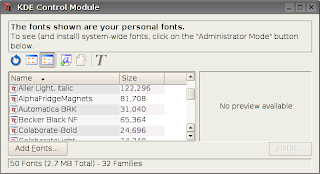Day 83 - The Mini Experiment Begins
I have yet to find an ideal web browser for the Eee. The default is Firefox, and while it has some fantastic features, it seems to freeze far more often in Xandros than with Ubuntu or Windows. And that's Firefox 2.0 – the beta 3 is molasses slow. I spent some time this weekend exploring my options in search of the perfect web browser for the Asus Eee PC.
The choices

I ran into the Firefox 3 slowdown when I was running gOS, so I installed Opera. It was quite fast, but many sites that I use in my professional life don't support Opera. It did all kinds of weird things to cascading menus, login screens, email pages, ect. I found myself using Opera for general surfing, but resorting to the slow Firefox when checking my mail. It got the job done but wasn't ideal.
 Last year I inherited an ancient Sony Vaio laptop that could barely run Windows 98. I restored it with a copy of Damn Small Linux, and the machine enjoyed a brief stint as my laptop of choice. DSL comes with Dillo – a tiny and lightning fast web browser. It worked, but I missed the added features of Firefox such as integrated spell check and tabbed browsing. Although Dillo is available in Synaptic, it's shortcomings removed it from the running to be my browser of choice on the Eee.
Last year I inherited an ancient Sony Vaio laptop that could barely run Windows 98. I restored it with a copy of Damn Small Linux, and the machine enjoyed a brief stint as my laptop of choice. DSL comes with Dillo – a tiny and lightning fast web browser. It worked, but I missed the added features of Firefox such as integrated spell check and tabbed browsing. Although Dillo is available in Synaptic, it's shortcomings removed it from the running to be my browser of choice on the Eee.
 Before installing anything new, I looked into using the Eee file browser, Konqueror, for the web. This can either be run by typing the name into the console, or by opening the home folder and then typing the web address into the address bar (add this by going to view --> toolbars --> address bar). I played with Konqueror for about an hour before abandoning it.
Before installing anything new, I looked into using the Eee file browser, Konqueror, for the web. This can either be run by typing the name into the console, or by opening the home folder and then typing the web address into the address bar (add this by going to view --> toolbars --> address bar). I played with Konqueror for about an hour before abandoning it.
(Begin Analogy)
Every year my family goes camping to the Thousand Islands region of the St. Lawrence Seaway for a week during the summer. We spend several days floating up and down the river in a tiny aluminum boat we rent from a retired lady named Mrs. Trevor. The boat is barely seaworthy, but she only charges 50 bucks a day and we are always game from an adventure. The rivets that hold the three parts of the hull together are so old it was not uncommon for one to spring a leak mid-boating. But we were always prepared – before renting from Mrs. Trevor we made a trip into town to buy a box of saltwater taffy. Not only was it delicious, it plugged the holes nicely. By the end of the week, our boat was covered in multicolored wads of the sticky treat.
(End Analogy)
Using Konqueror for web browsing is kind of like using taffy to plug holes in a boat. It gets the job done, but it was definitely designed for a more specific use.

There were no more browser choices in Synaptic, so I turned to the web. There I found whispers of something called Galeon that I thought might be worth trying. It took a bit of work locating a repository for it and all I could find was one for Debian, so I was hesitant about trying to install it on the Eee. But I held my breath, added the repository, and installed Galeon (directions for doing so are found
here).
It's not much to look at – reminiscent of Internet Explorer 5 - but it has tabs and seems to have no effort loading the pages that gave Opera a run for its money. It's lacking the built in spell check, but I think I can live with Galeon as a primary browser. For now, anyway.
So for the next five days, I plan to only use Galeon for browsing. If it can handle flash videos without freezing (like Firefox) and can be customized with add-ons (like Firefox), I might just consider Galeon for the long haul.












 Mules are the result of the love shared by a male donkey and a female horse. These two animals evolved from the same creature so they are still genetically similar enough to produce offspring. Only one problem - horses and donkeys have a differing number of chromosomes (64 and 62, respectively) which means the mule is actually a genetic mess. One major side effect of this darwinistic God-playing is that mules can never reproduce - they are born sterile.
Mules are the result of the love shared by a male donkey and a female horse. These two animals evolved from the same creature so they are still genetically similar enough to produce offspring. Only one problem - horses and donkeys have a differing number of chromosomes (64 and 62, respectively) which means the mule is actually a genetic mess. One major side effect of this darwinistic God-playing is that mules can never reproduce - they are born sterile. 